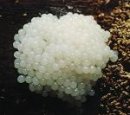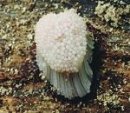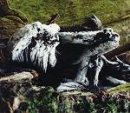SPORANGIA:. Sporangia narrowly cylindrical, in dense and often large clusters 10 to 50 mm in diameter, stalked, usually curved, rusty brown,total height 7 to 20 mm. With .individual Sporangium are 0.2 to 0.3 in diameter.
STALK: black, 3 to 7 mm. high, rising from a membranous hypothallus.
COLUMELLA: ending below the summit of the sporangium.
CAPILLITIUM: with a smooth and usually close surface-net, connected with the columella by few stout branches, and composed of rather firm threads bounding rounded meshes, which are usually small although varying in size.
NOTES: Off all the Stemonitis this is the most common. As with many members of this genus the plasmodium is able to find its way through decaying wood this enables fruiting on relatively dry logs after merging from within the log were it is still most.
SPORES: Brown 5 to 7 µm in diameter and almost smooth (minutely punctuate).
PLASMODIUM: white, rarely pale yellow.
HABITAT: On dead wood.
DISTRIBUTION: Cosmopolitan, known from Northland, Auckland, Coromandel, Taranaki, Taupo, Wanganui, Wellington, Westland, South Canterbury, Southland and Dunedin.
 First stages of producing
a fruiting body
First stages of producing
a fruiting body Nearly complete
prior to turning brown
Nearly complete
prior to turning brown An old specimen with mould growing on it
An old specimen with mould growing on it First stages of producing
a fruiting body
First stages of producing
a fruiting body Nearly complete
prior to turning brown
Nearly complete
prior to turning brown An old specimen with mould growing on it
An old specimen with mould growing on it